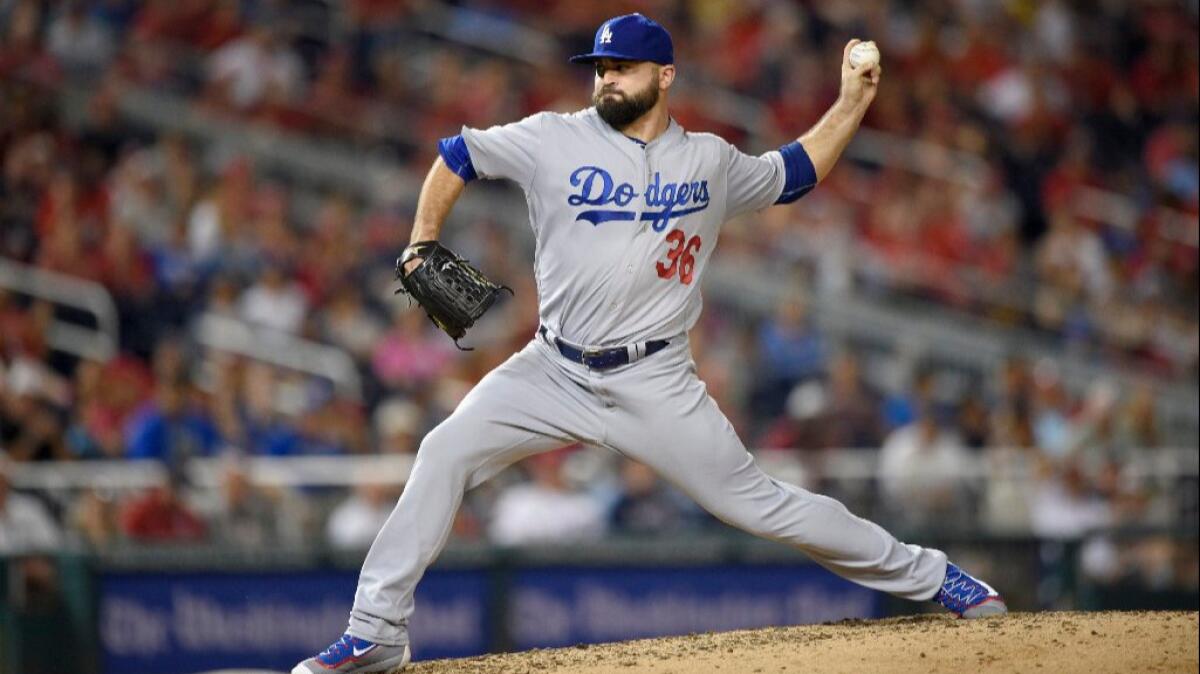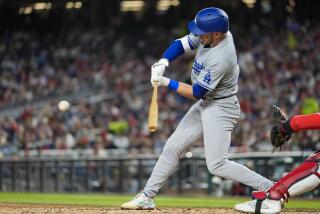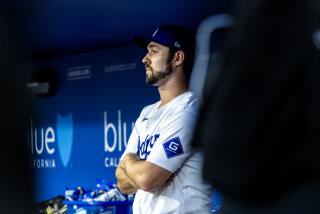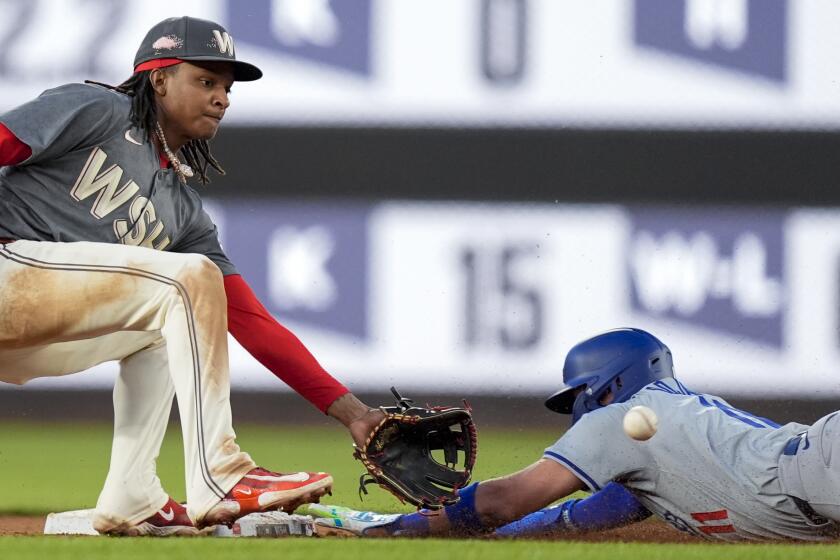The best lefty in the game? Adam Liberatore wants to show the Dodgers he’s that guy
The first substantive conversation Dodgers Manager Dave Roberts had with Adam Liberatore happened in late March, inside Roberts’ office at the club’s Camelback Ranch spring training complex in Arizona. The tone was unpleasant.
The rookie manager had the awkward assignment of sending a player to the minors. The second-year reliever fumed at the perceived slight.
Roberts asked Liberatore how he felt about the decision. Liberatore told him he did not agree. Roberts kept poking, asking Liberatore how he saw himself. Liberatore was two months away from his 29th birthday, with only 39 appearances in the majors. He answered with an assertion that took his manager aback.
“He prodded some answers out of me, and prodded some stuff out of me, just trying to figure out who I was, who he was dealing with,” Liberatore said. “So I let him know.”
I am the best lefty in the game, Liberatore told Roberts.
Prove it, Roberts replied.
The boast sounds less fanciful in July. Liberatore owned the lowest earned-run average in baseball before a hiccup on Sunday raised it to 1.35. He set a franchise record with 28 consecutive scoreless appearances. He graduated from a specialist assigned left-handed batters to one of Kenley Jansen’s setup men. In a bullpen that has kept the Dodgers aloft, Liberatore has become an unlikely pillar.
On a path pocked with pitfalls, Liberatore never allowed his confidence to flag. He underwent elbow ligament replacement surgery as a senior in college, and returned for a fifth season after 11 months of rehabilitation. Tampa Bay offered him a $1,500 bonus as a 21st-round pick in 2010. Liberatore took the deal. He lingered at triple A for parts three seasons before the Dodgers acquired him in 2015.
See the most-read stories in Sports this hour »
The men who shaped his development describe him in similar terms. Dodgers pitching coach Rick Honeycutt lauded him for attacking hitters. His coach at Tennessee Tech called him “a bulldog.” He stood out to Brad Matthews, the Rays scout who signed him, because “I loved his toughness,” Matthews said.
“What has propelled Adam, for me, is his will,” said Mitch Lukevics, Tampa Bay’s director of minor league operations. “Here’s a tough, blue-collar kid from Pennsylvania who willed his way to the big leagues.”
Liberatore grew up about an hour north of Pittsburgh, and pitched sparingly in high school. A member of Matt Bragga’s coaching staff at Tennessee Tech saw Liberatore throw in a showcase in summer 2005. His fastball velocity approached 90 mph, and Bragga understood how precious left-handed pitching can be.
The learning curve in college was steep. Liberatore posted an 8.88 ERA during his first three seasons, bedeviled by shaky command and too many ground-ball singles. When he returned as a senior, Bragga watched the parts click into place. In three starts, Liberatore struck out 21 batters in 17 scoreless innings.
The performance landed him on Matthews’ radar. He noticed the velocity, how Liberatore’s delivery added deception and his growing control of a slider. About a week later, he heard Liberatore blew out his elbow.
Liberatore could, conceivably, have called it a career. Instead, he raced through his rehabilitation so he could return for a fifth season in 2010. On the mound, his command was unreliable and his ERA was 5.30.
“A lot of [scouts] saw that, and I think a lot of those guys had not seen him pitch like I did the year earlier,” Matthews said. “So they just kind of walked away. Just knowing him, and knowing how soon he came back, and knowing what I’d seen in the past, I wasn’t going to back off of him.”
Matthews felt Liberatore was miscast as a starter. He lobbied for the Rays to choose him late in that June’s draft. The organization assigned him to Class-A Hudson Valley. At 23, Liberatore was one of the oldest players on the roster.
“Some kids come in with a chip on their shoulder,” Lukevics said. “Like, ‘Screw you. I’m a 21st-round pick. I’m going to show you that I’m better than that.’ He’s one of those guys who did that.”
Two years later, Liberatore reached triple-A Durham. He became a fixture on the Bulls’ roster. In 2014, he struck out 86 batters in 65 innings with a 1.66 ERA. And still he did not merit a call-up. Tampa Bay felt there was little room in their big-league bullpen, and Liberatore needed to sharpen a third pitch to combat right-handed batters.
Keep grinding it out, Rays staffers told Liberatore. Your turn is going to come.
“He has that cocky confidence, he has that disposition, that ‘when my time comes, I’m going to prove I belong,’” Lukevics said. “Not everybody has that.”

The opportunity did not arise with Tampa Bay. Liberatore benefited from Andrew Friedman’s move west. The first trade Friedman completed as the Dodgers’ president of baseball operations netted Liberatore and fellow reliever Joel Peralta.
Liberatore completed a credible campaign in 2015, with a 4.25 ERA in 29 outings, but he still felt he relied on his fastball too often. He resolved to increase the usage of his slider and splitter. The mixture balanced his arsenal and provided weapons against right-handers.
“This year, I came in with the mentality like ‘I have to throw that stuff.’ ” Liberatore said. “To keep hitters off balance, I have to use my stuff.”
He maintained that attitude during his brief stay with triple-A Oklahoma City. Called up in mid-April, Liberatore has made himself indispensable.
The scoreless appearance streak started on May 20 in San Diego. Liberatore got a ground out from left-handed hitter Travis Jankowski and exited the game. A night later, he faced two more batters. Over the next two months, his role expanded from complementary into crucial. He and Joe Blanton became the bridge to Jansen.
Roberts showed his faith in Liberatore on July 16 in Arizona. He granted him a supreme sign of respect: He let him face right-handed Diamondbacks slugger Paul Goldschmidt. Liberatore got ahead with a fastball away and got away with a hanging splitter. He challenged Goldschmidt with a 2-2, 92-mph fastball at the waist. Goldschmidt swung through it.
“He just comes in and attacks,” Honeycutt said. “For the most part, the biggest positive is he’s putting the hitter on the defensive, because he’s coming right at you with good stuff.”
The streak ended Sunday, when Liberatore lost his command and left the bases loaded for Blanton. All three inherited runners scored. But his importance to the club has not changed.
Liberatore may not be the best lefty in baseball. But nearly four months into 2016, the claim no longer sounds farfetched.
“I like when people say things, and they back ’em up,” Roberts said. “He said that. And I challenged him. And he responded.”
Follow Andy McCullough on Twitter @McCulloughTimes
MORE SPORTS NEWS
NFL: ‘No credible evidence’ that Peyton Manning used performance-enhancing substances
Seven Russian swimmers out of Rio Olympics as questions swirl over the nation’s team
More to Read
Are you a true-blue fan?
Get our Dodgers Dugout newsletter for insights, news and much more.
You may occasionally receive promotional content from the Los Angeles Times.






